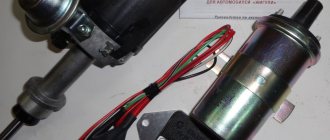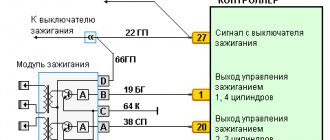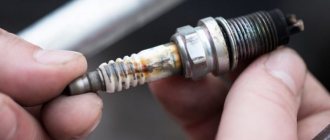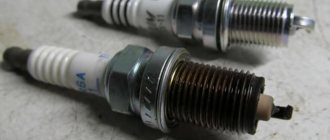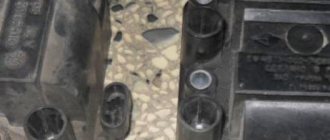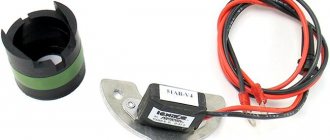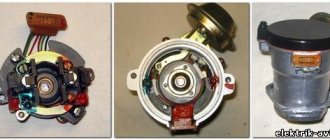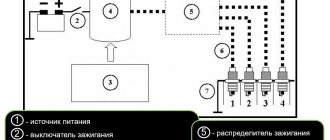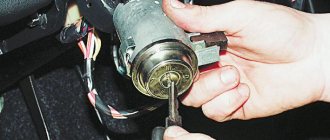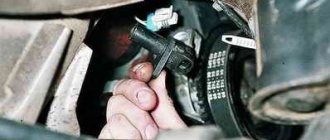Along with engine oil, filters and brake pads, spark plugs are among the items in high demand in the range of automotive spare parts. Just 10-15 years ago, not a single self-respecting motorist set off on a long journey without a spare set of spark plugs. After all, the performance of the engine completely depends on the quality of their work.
What are spark plugs for, how do they work, how do they differ, which spark plugs are better, how can you diagnose engine operation and fuel quality based on their condition - these are a range of issues that are important to understand for car enthusiasts who care about the technical condition of their car.
Purpose and design of spark plugs
Automotive spark plugs are designed to ignite the fuel-air mixture in the combustion chamber of an internal combustion engine by producing a spark.
The design of automobile spark plugs is quite simple; it has remained virtually unchanged since 1902, the time of its invention by the famous German engineer Bosch. The main components of a candle are:
- contact pin;
- central electrode;
- side electrode;
- insulator;
- threaded metal frame (body);
- seals.
The spark plug works as follows: high voltage from the car's ignition coil is supplied at strictly defined points in time through the contact terminal of the spark plug to its central electrode. An electrical discharge occurs in the gap between the central and side electrodes, accompanied by sparking. It is, in fact, at this moment that the air-fuel mixture ignites in the engine combustion chamber.
This process is very clearly demonstrated in the animated and video materials of the article Design and principle of operation of the internal combustion engine.
It would seem that everything is simple: two electrodes and high voltage, but the difficulties lie in the technological nuances. The specificity of the operation of a spark plug is not only that it occurs using high-voltage equipment, but also that complex high-temperature transient processes occur both in the spark plug itself and in the environment (in other words, sharp changes in high temperatures). All these processes determine the choice and use of materials in its production.
Thus, the insulator, which serves to prevent breakdown of the high voltage supplied to the contact wire to the body parts (ground) of the engine, is made of high-strength technical ceramics. In addition to this function, the insulator performs the function of dissipating heat to the cylinder head.
Leakage currents are always present in high-voltage electrical circuits. Ring ribs on the outer surface of the insulator serve to increase resistance to leakage currents: they lengthen their path to the housing parts.
A high-voltage discharge is a source of radio interference for audio equipment turned on in the car. To suppress interference in some types of spark plugs, a resistor is installed in the middle part of the contact wire - a conductive mass made of glass material.
The contact terminal is usually made of a nickel alloy, and some manufacturers also contain a copper core for heat dissipation.
The same task - heat removal during operation - is performed by a metal body with a thread cut on it, and the external sealing ring, in addition to preventing the breakthrough of combustion products, also compensates for the difference in thermal conductivity of the cylinder head and the spark plug body.
Diagnostics of the engine condition by the appearance of the spark plugs
A careful inspection of the spark plugs allows you to indirectly identify problems with the engine. If unusual sounds appear during engine operation or jerks in movement, it is worth inspecting the spark plugs.
1. Normal candle. Brown or grayish-yellowish and slight wear on the electrodes. Exact matching of the spark plug thermal value for the engine and operating conditions.
Note:
When replacing spark plugs with new ones, install spark plugs with the same characteristics recommended by the manufacturer.
2. Soot deposits. Dry soot deposits indicate a rich air/fuel mixture or late ignition. Causes misfire, difficult engine starting and unstable engine operation. Check if the air filter is clogged and if the coolant and intake air temperature sensors are working properly.
Note:
Use a hotter candle.
3. Oil deposits. Oily electrodes and spark plug insulator. The reason is oil getting into the combustion chamber. Oil enters the combustion chamber through valve guides or piston rings. Causes difficult starting, cylinder misfires and “twitching” of a running engine. The cylinder head and piston group of the engine need to be repaired. Replace spark plugs.
4. Metal-containing plaque. Deposits on the insulator skirt of brick-red iron oxides from anti-knock iron-containing additives (ferrocenes) to gasoline. They are deposited in an even, dense layer. When the engine operates under heavy load under the influence of high temperature and pressure in the combustion chamber, the oxides are reduced into conductive tracks of pure iron, which close the central electrode to ground. This causes misfires and, as a result, a drop in engine power and increased fuel consumption. In addition, the catalytic converter of the exhaust gases may be damaged, overheating greatly when unburned gasoline enters the engine cylinders. The plaque is practically not removed mechanically and does not fade during prolonged movement at high speed. If this deposit appears on new spark plugs after a short mileage, change the refueling location.
Note:
If it is not possible to immediately replace the spark plugs with new ones, try to remove this deposit by immersing the spark plugs with their insulator skirts for ten minutes in phosphoric acid or a rust converter (contains phosphoric acid). After this, clean the plaque with a non-metallic brush (or an old toothbrush) and rinse the spark plugs first with water and then with gasoline.
5. Melted electrodes. Early ignition. The insulator is white, but may be contaminated due to missed sparks and deposits from the combustion chamber falling on it. May cause engine damage. It is necessary to check the suitability of the spark plug type, the cleanliness of the injector nozzles and fuel filter, and the operation of the cooling and lubrication systems.
6. Ash deposits. Light brown deposits crusting over the center and side electrodes. Isolated from additives to oil or gasoline. A large number of them can lead to insulation of the spark plug electrodes, causing misfires and interruptions during acceleration. If excessive deposits form over a short period of time or low mileage, replace the valve guide seals to prevent oil from entering the combustion chamber.
Note:
If deposits consistently form over a long run, the reason is the quality of gasoline - change the refueling location.
7. The spark plug insulator is cracked or chipped. Detonation. This may damage the piston. Make sure that the octane number of gasoline matches the required one.
8. Mechanical damage to the electrodes and spark plug insulator. Damage can be caused by foreign objects getting into the combustion chamber, and if you use a spark plug that is too long, its electrodes can catch on the piston. This causes spark plug destruction, cylinder shutdown and can damage the piston. Remove the foreign object from the cylinder and/or replace the spark plug.
The article is missing:
- High-quality photos of repairs
Source: https://remont-nissan-almera.net/neispravnosti-v-puti/47-diagnostika-sostoyaniya-dvigatelya-po-vneshnemu-vidu-svechey-zazhiganiya.html
Main types of automotive spark plugs
Conventionally, the entire variety of spark plugs can be divided into three classes:
- Traditional two-electrode ones - their design is described in detail above - are the most common class;
- Multielectrode - in terms of scope of application they are inferior to traditional ones. However, they are quite popular among car enthusiasts;
- Torch and pre-chamber (or plasma-pre-chamber) - were first used in sports cars, and then in ordinary passenger cars, but their scope is currently limited by the level of confidence of motorists.
Even minor design changes seriously affect the performance of traditional two-electrode spark plugs. For example, on some models, a V-shaped notch is made on the surface of the central electrode or a U-shaped recess on the surface of the side electrode. Of course, these changes do not extend the life of the spark plug, but they do help increase the sparking area. In some types of engines, spark plugs with an elongated central electrode are used to improve the spark formation process.
Two-electrode spark plugs
In a large class of traditional two-electrode spark plugs, two subclasses are usually distinguished:
- Spark plugs in which the central electrode is made of homogeneous metal;
- Bimetallic - a coating of another metal is applied to the working surface of the central electrode, which improves the characteristics of the spark plug.
The main advantages of traditional candles are price and time-tested reliability.
The main disadvantages are limited service life, unstable spark formation parameters, low efficiency under cold engine start conditions.
The use of bimetallic compounds has become the main direction in improving two-electrode spark plugs. First of all, the changes affected the material of the core of the electrodes: if the material of homogeneous electrodes was nickel-containing steel, then the core of the new electrodes began to be made of copper.
This technology made it possible to improve heat removal from the working surface of the central electrode and, as a result, reduce the intensity of electrical erosion processes, and therefore increase the service life of the spark plug. This technology has improved the anti-carbon properties of the side electrode.
The next stage in the use of bimetallic compounds was the use of noble metals in the central electrode material: iridium and platinum (or rather, their alloys). platinum and iridium spark plugs appeared .
Iridium has high refractoriness (transition temperature to the liquid state is 2450°C) and increased resistance to electrochemical corrosion. Thanks to these properties, engineers were able to not only dramatically increase the durability of spark plugs, but also improve other characteristics. The fact is that due to the increased strength, it was possible to sharply (several times) reduce the diameter of the central electrode (to 0.4 mm), which in turn reduced the sparking voltage and increased its efficiency.
Iridium spark plug
Platinum spark plugs have similar characteristics to iridium spark plugs. The main and, perhaps, the only drawback of platinum and iridium spark plugs is their high price. Perhaps maintenance can also be included here: while conventional candles can be mechanically cleaned of carbon deposits, platinum and iridium elements must be treated with much more care.
Multi-electrode spark plugs
In multi-electrode spark plugs, there are several side electrodes and they are usually located in a circle around the central electrode.
Multi-electrode spark plug
Sparking between the central and one of the side electrodes occurs randomly, and if any side electrode fails, its functions are “transferred” to the adjacent electrode. The main advantage of such spark plugs is a reduction in the load on the single side electrode compared to a traditional circuit and, accordingly, an increased service life compared to a two-electrode analogue.
In addition, in a two-electrode spark plug, the side electrode, due to its asymmetrical location (relative to the central electrode), screens part of the space behind it. Because of this, the spark formation zone is also asymmetrical with respect to the axis of the spark plug. With a multi-electrode design, this does not happen, and the fuel is burned more efficiently.
The main disadvantages of multi-electrode spark plugs are their relatively high cost and longer recovery (drying) time after cold starts.
Prechamber spark plugs
In prechamber spark plugs, the space around the central electrode is shaped like a rocket engine nozzle.
Prechamber spark plug
The high-voltage discharge between the electrodes is converted into a plasma clot, which, thanks to the geometry of the interelectrode space, is “shot” into the engine cylinders along with the combustion products. In this way, volumetric ignition of the fuel is formed, which, unlike traditional (rather point-based in this terminology) ignition, ensures more efficient and complete combustion.
In practice, prechamber spark plugs showed really good results when operating at high speeds, but at lower speeds they turned out to be worse than traditional ones. In addition, they are more expensive than previous classes. Therefore, the use of pre-chamber spark plugs in mass-market passenger cars is limited both technically and economically.
Signs and causes of spark plug failure
Spark plugs and glow plugs fail sooner or later. This can be caused by various reasons - natural aging, use of low-quality fuel and mechanical damage. Let's take a closer look at the signs and reasons for their failure.
Symptoms of a problem
Let's start with spark plugs, as they are more common. So, signs of their malfunction include:
- difficulties when starting the engine (usually this is accompanied by prolonged operation of the starter);
- the engine “troits” (the car jerks when moving, picks up speed poorly, it lacks traction and power);
- significant increase in fuel consumption;
- increase in the amount of CO in exhaust gases;
- decreased engine dynamics (insufficient speed).
Spark plug device: 1 - thread; 2 — end of the body (rim): 3 — side electrode: 4 — central electrode; 5 — thermal cone of insulator (“skirt”)
It is worth mentioning here that the listed signs may indicate other engine malfunctions. However, if at least one of them appears, it is necessary to check the condition of the spark plugs, especially since this is not difficult to do.
Now let's move on to the glow plugs. Signs of their failure are:
- Difficulty starting the engine in cold weather. In particularly difficult cases, it is impossible to start the car at all.
- The engine runs rough at idle speed .
- White smoke comes out of the exhaust pipe (simulating a rich fuel-air mixture);
- Inoperative spiral indicator on the dashboard. If it does not light up, then there is a high probability that the temperature sensor or fuse has failed, but sometimes it can also indicate a failure of the spark plugs. But when this light bulb glows constantly. In this case, the thermal switch will most likely need to be replaced. If this is not done in time, the glow plug may fail completely.
Now let's move on directly to the reasons why the spark plugs failed.
Causes of malfunctions
Let's start again with the spark plugs. The reason for their partial or complete failure may be:
Worn and new spark plugs
- natural wear and tear;
- the presence of a large amount of soot;
- presence of oil on the electrodes;
- varnish deposits;
- slag deposits;
- failure of the central electrode;
- candle melting;
- spark plug connector wear.
As for glow plugs, the causes of their malfunctions may be:
- natural wear and tear;
- low quality diesel fuel (presence of moisture or various impurities);
- problems with electrical wiring;
- problems with the electronic control unit.
As a rule, one spark plug fails. If two spark plugs are faulty at once, the engine simply will not start. But if all the existing ones fail, then the reason must be sought, most likely, in the ECU.
Rules for selecting spark plugs
When selecting a spark plug for the engine of a specific car model, as a rule, two characteristics are taken into account:
- Geometric dimensions;
- Heat number.
The determining factor in geometric dimensions is the size of the threaded connection and its length.
If everything is clear with the threaded connection (non-standard threads simply won’t work), then the length of the spark plug must correspond to that specified by the manufacturer, otherwise it may “meet” with the piston!
What is heat number and heat ignition?
To understand how important it is to use spark plugs with the correct heat rating, you need to understand the essence of the processes occurring in the combustion chamber of the engine. Let's start with the terms.
- The heat number is a conditional thermal equivalent that indicates the maximum permissible temperature load of the spark plug, above which heat ignition appears in the engine cylinder.
- Glow ignition is an uncontrolled process of chaotic ignition of the working mixture from a red-hot spark plug without the formation of a spark.
The fact is that during operation the surface of the candle heats up to a high temperature: 600 – 800 °C. At this temperature, the oil that gets on its body almost completely burns out (self-cleaning of the electrodes occurs). However, in combination with high pressure in the combustion chamber, the hot part of the spark plug is a source for self-ignition of the air-fuel mixture without the formation of a spark.
Manufacturers achieve a balance of heat transfer between the combustion chamber, spark plug, cylinder head and the external environment by selecting materials with suitable characteristics.
For high-speed engines with high compression ratios, the spark plug must provide better heat transfer than in less loaded engines. In this case, the heat number should be high, and the candles themselves are called cold for this reason.
On the contrary, for low-speed engines with a low compression ratio, the heat rating must be low for the operating temperature at which the self-cleaning process occurs. Such candles are called hot candles.
The importance of correctly selecting the heat number cannot be overestimated:
- When installing hot spark plugs in a heavily loaded engine, there is a high probability of them overheating to temperatures above 1000 °C, subsequent melting and entering the combustion chamber.
- When installing cold spark plugs in low-speed engines, the working surface does not heat up to the optimal temperature and their self-cleaning process does not occur.
Modern engine building is developing in the direction of increasing specific power, increasing the compression ratio, and using supercharging systems. Accordingly, the heat rating requirements are shifting towards the use of increasingly colder spark plugs.
But not only this trend is important: taking into account the fact that the actual operation of engines occurs in a wide range of loading conditions, spark plugs with an expanded range of heat ratings are increasingly in demand.
In Russia, the glow number is quantified as the average pressure at which glow ignition occurs and is expressed in conventional units.
The markings on modern spark plugs indicating the heat rating of domestic manufacturers differ from their foreign counterparts. So in our country the following series of heat numbers is generally accepted:
- 11-14 - hot candles;
- 17-19 - medium candles;
- 20 or more - cold candles.
There are also standardized spark plugs with a heat rating from 11 to 20, but they are less common.
Carbon deposits on spark plugs - color matters
Carbon deposits on spark plugs are a fairly common problem that many of our car enthusiasts face. At first glance, it may seem that there is nothing wrong with this. But this is not true, especially if there are certain reasons why plaque forms on devices. What to do in such cases? Find out in this article.
What does soot mean, how can you determine the condition of an injector or carburetor by its appearance at home? Ideally, the service life of spark plugs is 50 thousand km, that is, when the car passes this mileage, they must be changed in any case. If the plaque, as can be seen from the photo, is relatively small, then there is nothing to worry about, the main thing is that there are no signs of damage on the electrodes. But if plaque appears on new elements, then this needs to be given importance, since the reasons for this condition can be serious (video author - Oleg Ars).
This is interesting: Why Vesta turned out to be more popular than X-Ray: comparative analysis
Soot color - what does it indicate and what to do?
First, you need to carefully diagnose the devices; one or another shade of plaque can tell the motorist a lot, in particular, in this way you can detect weak points. Replacing elements on a carburetor or injector is not a problem, just like cleaning the spark plugs, the main thing is to understand what caused this condition. After all, if the problem is not solved in a timely manner, then the new candles will quickly deteriorate.
What color can carbon deposits on spark plugs be? Black, red or white. Any of these raids indicates that there are certain problems in the operation of the vehicle. Engine diagnostics using spark plugs often gives certain results, allowing you to identify the problem. Let's look at each of these colors.
Black soot
Black carbon deposits on the spark plugs of a carburetor or injector can result from a variety of problems. There can be two types of plaque - it can be either dry or oily. So why are spark plugs black?
Let's look at the main reasons for this condition:
- The carburetor is not working correctly, the device needs to be adjusted and cleaned.
- The air filter element is clogged. A replacement needs to be made.
- The pressure level in the fuel rail is too high.
- The spark energy is too low.
- Compression level too low.
If oil deposits form on the elements, then you need to make sure that the engine fluid does not enter the combustible mixture. As practice shows, the main reason in this case is wear of the oil scraper piston rings. In addition, damage to the valve caps can also cause plaque, as can be seen from the photo.
White plaque
As for the soot, it is white, as can be seen in the photo, but it can also appear for various reasons, especially since it can have several shades:
- Ash shade. In most cases, such deposits appear when you refuel your vehicle with low-quality fuel. It is quite possible to solve the cause of the problem with your own hands - just clean the elements and they can be used again. Of course, after this you should fill in with higher quality fuel.
- A shiny shade may be accompanied by erosion on the contacts. This condition indicates overheating of the components. As a rule, overheating occurs if the combustible mixture is slightly enriched. Also, the reason may lie in an incorrectly configured ignition (too early) or incorrect operation of the cooling system. As for overheating specifically, it can be quite dangerous, since over time it can lead to the formation of cracks and other damage, so if a shiny coating is detected, it is better to replace the parts.
Red and brown soot
Brown or red soot on the spark plugs may indicate that the gasoline poured into the tank contains substances harmful to the engine or that the oil contains a large number of additives. If the shade is similar to the color of red brick, then this indicates that the car owner has been filling with leaded fuel for a long time. As a result of the fact that a brown coating appears on the ends of the spark plugs, the device will not be able to pass a spark. The only solution in this case is to clean the spark plugs.
The device may not produce a spark if its electrodes are clogged. You can try to clean the element, but most domestic drivers take the easier route - they simply change the SZ. Brown soot may have a yellow tint. If the coating is yellow, then this indicates a lean combustible mixture in the engine.
Other factors that indicate there is a problem
It's not just the color that can tell you that there are problems with the engine. For example, if you notice that erosion has formed on the electrodes, then most likely you are using low-quality gasoline, which has a high lead content. Poor clearance also contributes to erosion. Ash itself is an insulator; therefore, if its layer is too thick, then the required voltage will not be able to develop in the system. The appearance of ash is facilitated by the fact that the engine fluid does not burn completely in the engine cylinders, which is due to other problems associated with the piston rings.
As for motor fluid residues on the electrodes, they indicate failure of the valves or partitions; metal shavings may also be located on the electrodes.
In this case, the system is again filled with gasoline, which is why this happens:
- the system as a whole is not working properly;
- There were problems with the ignition.
If the vehicle is stationary for a long time, at the beginning of its operation the internal combustion engine may experience tripping, which disappears over time. In this case, blue-white smoke will come out of the muffler. In this case, the problem most likely lies in the cylinder temperature. Oil forms on the spark plugs when the spark plug itself is cold, or when there is a need to replace the oil caps or piston rings.
If the problem is not resolved in a timely manner, fuel consumption may double, and if the malfunction is related to the piston rings or partitions, then it will have to be solved in any case. And it’s better not to delay this moment!
How to clean spark plugs yourself?
How to clean spark plugs - there may be several options; first, all devices must be dismantled; only the electrodes can be cleaned:
- Manual cleaning. Experts do not recommend cleaning elements with sandpaper, but our car enthusiasts still successfully use this method. A better option would be to use a special brush with a metal wire or a toothbrush.
- Cleaning with sand. Cleaning an element with sand is not so easy if you do not approach this issue correctly. Our craftsmen always find simpler ways, one of which is to install the device in a drill chuck, turn it on and lower it into a container with sand.
- Thermal method. The elements must be heated using a regular soldering iron or gas stove. The component is heated until the electrode turns red, after which it is cleaned with a brush.
- Cleaning with chemicals. If you use a special anti-rust product, apply it in a layer of a few millimeters and leave the devices for an hour, then clean them and rinse them in water. Regular acetone is used in the same way. For this purpose, you can use silit - the elements are filled with the substance, after which the jar with them is placed under pressure of hot water for an hour, then the electrodes are simply cleaned.
- Vinegar. Also, for about 60 minutes, the devices must be filled with ordinary vinegar and left to brew. After an hour, you need to add a few drops of electrolyte, the parts are cleaned with a wooden stick or toothpick. In practice, this method is quite effective. In a similar way, some motorists clean using drinks such as Coca-Cola, Pepsi, Sprite, etc. It's no secret that the substances included in these products remove rust without any problems.
Video “Cleaning spark plugs at home”
The cleaning procedure is presented in detail in the video below (the author of the video is Avtoelektika HF).
Table of interchangeability of spark plugs produced by different manufacturers
| Russia | Beru | Bosch | Brisk | Champion | NGK | Nippon Denso |
| A11, A11-1, A11-3 | 14-9A | W9A | N19 | L86 | B4H | W14F |
| A11P | 14R-9A | WR9A | NR19 | RL86 | BR4H | W14FR |
| A14B, A14B-2 | 14-8B | W8B | N17Y | L92Y | BP5H | W16FP |
| A14VM | 14-8BU | W8BC | N17YC | L92YC | BP5HS | W16FP-U |
| A14VR | 14R-7B | WR8B | NR17Y | — | BPR5H | W14FPR |
| A14D | 14-8C | W8C | L17 | N5 | B5EB | W17E |
| A14DV | 14-8D | W8D | L17Y | N11Y | BP5E | W16EX |
| A14DVR | 14R-8D | WR8D | LR17Y | NR11Y | BPR5E | W16EXR |
| A14DVRM | 14R-8DU | WR8DC | LR17YC | RN11YC | BPR5E | W16EXR-U |
| A17B | 14-7B | W7B | N15Y | L87Y | BPR5ES | W20FP |
| A17D | 14-7C | W7C | L15 | N4 | BP6H | W20EA |
| A17DV, A17DV-1, A17DV-10 | 14-7D | W7D | L15Y | N9Y | B6EM | W20EP |
| A17DVM | 14-7DU | W7DC | L15YC | N9YC | BP6E | W20EP-U |
| A17DVR | 14R-7D | WR7D | LR15Y | RN9Y | BP6ES | W20EXR |
| A17DVRM | 14R-7DU | WR7DC | LR15YC | TRN9YC | BPR6ES | W20EPR-U |
| AU17DVRM | 14FR-7DU | FR7DCU | DR15YC | RC9YC | BCPR6ES | Q20PR-U |
| A20D, A20D-1 | 14-6C | W6C | L14 | N3 | B7E | W22ES |
| A23-2 | 14-5A | W5A | N12 | L82 | B8H | W24FS |
| A23B | 14-5B | W5B | N12Y | L82Y | BP8H | W24FP |
| A23DM | 14-5CU | W5CC | L82C | N3C | B8ES | W24ES-U |
| A23DVM | 14-5DU | W5DC | L12YC | N6YC | BP8ES | W24EP-U |
It should be remembered that for each engine it is necessary to use spark plugs only of the type recommended by the car manufacturer. Other types of devices disrupt the operation of the engine by forming carbon deposits, oiling and overheating the spark plug insulators.
When you need to select spark plugs according to the car make, first of all, turn to the operating instructions. Some automakers indicate not only geometric parameters and heat ratings, but also a list of acceptable analogues.
If the car is many years old, there is no instruction manual or there is no data on the “original” spark plugs, we recommend unscrewing any of them from the engine and copying all readable parameters from it. Manufacturers of spark plugs usually indicate not only their characteristics, but also their applicability in various brands of cars.
Rating of spark plug manufacturers
The rating of spark plug manufacturers on the Russian market has long been established. The first positions are invariably occupied by 5 world-famous companies:
- Bosch , the founder of the development and production of spark plugs, has factories in 5 countries, including Russia, and the products of the Russian plant are exported to other countries;
- NGK is a Japanese company, in many ratings the world leader among manufacturers, the main supplier of such giants as Toyota, Nissan and Honda and most Formula 1 racing teams. It has 15 factories in different countries;
- Denso is also a famous Japanese brand, together with NGK it owns a 40% share of the world market. It was Denso that developed and released spark plugs with iridium and platinum electrodes;
- Brisk is a Czech company that has preserved the long traditions of the Czech automobile industry. It owns about 20% of the Russian market and a plant in Togliatti with more than 500 employees;
- Champion is a US company focused on the American market. Spark plugs are not the only products of the company. Experts believe that Champion components can be found in 80% of new cars, which is why the company is well known in Russia.
Where does red carbon come from on spark plugs?
Many people can see the characteristic red soot on their spark plugs. I was always interested to know the reason for this red color. In Figure 1 you can see the color of an ordinary working candle. And compare it with a photograph of a candle with a red soot formed as a result of work . It seemed like it would be red, so I turned it around and drove on. But not many people realize that, in principle, candles in such a deplorable state can be safely thrown away, no matter how much you regret the money spent.
Therefore, it is worth finding out the reason for such terrible soot. Your spark plugs turn red because gasoline manufacturers add manganese-iron anti-knock additives to the fuel.
Is this normal, you ask? Of course not, because by adding such additives to gasoline, unscrupulous sellers increase the octane number of gasoline . And they sell it as expensive high-octane premium quality gasoline. This practice is typical for 95 and 98 gasoline, which is obtained from 92 gasoline.
Long-term use of scorched gasoline leads to metal deposits on the working surface of the spark plug, as a result of which the tip turns brick-colored. But this is only the tip of the iceberg, since a conductive film (plaque) forms on the spark plug, and as a result, the spark plug’s insulation between the electrodes drops significantly. It is much easier for current to pass through the insulation than to punch a gap on the spark plug. Such candles become absolutely useless .
In other words, the next time you change spark plugs, pay attention to whether there is red carbon on them , and if so, then think about which gas station you should refuel at next time.
After surfing the Internet, you can read advice for car enthusiasts about how dead spark plugs can be revived by rinsing in a toilet bowl cleaner, such as Silit Beng. After carrying out this procedure, of course, there is no guarantee of a positive result, but it’s worth a try.
How often do you need to change the spark plugs in your car?
Spark plugs are classified as consumables in the spare parts range. This is understandable: their resource is limited by the manufacturer and ranges from 15-30 thousand kilometers (for standard nickel spark plugs) to 100 thousand or more (for iridium spark plugs).
The use of expensive spark plugs with higher durability recommended by the automaker is sometimes determined by the design of the car: replacing them requires quite labor-intensive operations that also require qualifications (for example, Subaru boxer engines or a Chevrolet Captiva engine).
In the Opel and Ford model range, gasoline engines are especially sensitive to prolonged misfires when at least one spark plug fails, which can lead to the breakdown of an expensive ignition unit. Therefore, their replacement interval in such models should not exceed more than 20–30 thousand km.
On engines using natural gas as fuel, the replacement interval is reduced to 10 thousand km: the combustion temperature of the gas is higher and the spark plugs are exposed to greater temperature loads than in gasoline engines.
Determining the condition of the car by spark plugs
One of the options for determining the cause of malfunctions in the operation of a car engine may be to conduct diagnostics of spark plugs.
In a gasoline engine, the job of spark plugs is to ensure the combustion of a mixture of fuel and air, which is ignited by a spark. The spark plug, which is actually located in the combustion chamber of the fuel, is made of metal and ceramic.
Thanks to this feature, the car owner has the opportunity to determine the serviceability of the engine, as well as its general condition, since the presence of certain problems can affect the combustion efficiency of the fuel mixture. Given the ease of dismantling, most experienced drivers and car enthusiasts use them to diagnose the condition of the engine.
Preparing for diagnosis. First of all, it is worth considering the fact that you can unscrew the spark plugs to carry out diagnostic measures after the engine has reached operating temperature and several tens of kilometers have been driven. Unscrewing the spark plug from a cold engine will not give the desired result. Before carrying out the inspection, you can drive along the highway, bringing the engine to medium speed. The reason is that immediately after starting, the engine will run on a rich fuel mixture for some time, and the operation of the engine itself will be unstable, especially at low air temperatures.
In order to have maximum confidence in the reliability of the data obtained, it is worth installing clean spark plugs in the combustion chambers, or purchasing a new set of them. It is worth paying special attention to the compliance of the installed spark plugs with the engine in terms of parameters such as heat rating and physical size. For a successful check, the mileage after their installation must be at least 200 kilometers. After this, the engine should be well warmed up and then used for 15-20 kilometers. After this, you can unscrew the spark plugs to diagnose the power plant.
Checking spark plugs and assessing engine performance. In an engine that is operating properly, there should be no carbon deposits, heavy deposits of any kind, or traces of oil on the spark plugs. It is acceptable to dye the skirt light brown. This indicates normal engine operation, with optimal fuel consumption and complete combustion of the mixture.
- If there is black carbon deposits and a fluffy structure on the central electrode, this indicates increased fuel consumption and excessive enrichment of the fuel-air mixture. The reason for this may be incorrect carburetor injection settings or injector operation. In addition, it is worth paying attention to the intake system, since excessive enrichment of the fuel mixture may result from a clogged air filter;
- The presence of a gray or white tint on the central electrode indicates that the working mixture is too lean. In this case, it is necessary to perform a comprehensive check of all systems to find out the cause. The consequence may be overheating of the combustion chamber and spark plugs, which will lead to possible detonation, overheating and even burnout of the exhaust valves;
- The red or brick color of the electrode indicates that the gasoline used contains additives that contain metallic impurities.
Bottom line. Spark plugs are one of the most informative sources of engine condition. They can be used to determine whether the engine is working normally, or to find out the cause of malfunctions in its operation.
- Premium electricity. Test drive Audi e-tron
See all photo news >>
The main signs of spark plug malfunctions and how to check them
Faulty spark plugs inevitably affect engine performance. Main external manifestations of malfunctions:
- Difficulty starting (multiple cranking with the starter does not produce results);
- The engine “troits” - unstable operation at idle, a sharp drop in traction, twitching when moving;
- A sharp increase in fuel consumption and carbon monoxide (carbon monoxide) in the exhaust gases.
In a normally working spark plug, the color of the central electrode insulator should be light coffee or gray. There should be no traces of dark deposits or soot on the electrodes.
The most common question among car enthusiasts is: “Why are the spark plugs black?” has several answers.
In the case of a rich fuel mixture (the result of incorrect adjustment or malfunction of the engine management system), a velvety black coating forms on the spark plugs - soot.
A wet black deposit with the smell of gasoline may be evidence of low-quality fuel. An example in the next photo.
An incorrectly selected heat value can also cause black carbon deposits to form on the candles, since the self-cleaning process does not occur.
A lean fuel mixture can cause a white coating to appear on the electrodes.
If a white coating is accompanied by traces of melting of the electrode, then this may be evidence of an incorrectly selected too hot spark plug according to the heat rating.
Taking into account the availability in most car brands, determining the condition of spark plugs is not difficult, and information about their color and foreign deposits will tell a lot about the condition of the power unit.
How to determine the condition of the engine by the spark plug
Before unscrewing the spark plug, thoroughly clean the area around the spark plug from dirt so that dirt does not get into the cylinder.
Look at the photos and remember what the spark plug looks like under different engine conditions.
Photo 1 shows the normal condition of the candle. Gray-brown color and minor wear on electrodes. The glow value of the spark plug corresponds to the type of engine and its general condition.
The second photo shows a candle with black carbon deposits on the insulator skirt. This indicates an over-enriched mixture and increased fuel consumption. The carburetor is incorrectly adjusted or the injector is faulty. The air filter may be clogged.
The third photo shows the condition of the spark plug with an excessively lean air-fuel mixture. The color of the electrode is from light gray to white. This is a dangerous condition. When driving with a very lean mixture and increased loads, significant overheating of both the spark plug itself and the combustion chamber occurs, which can lead to burnout of the exhaust valves.
In photo 4, the skirt of the central electrode has a reddish tint, similar to a brick. This color of the skirt is due to the presence of a large number of additives containing metal in the fuel. Long-term operation of the engine on such fuel will lead to spark plug failure, since the thick coating from the additives conducts electric current.
The candle in photo 5 is oily, this is especially noticeable on the threaded part. This indicates that the oil reflecting caps are worn out. An engine with such spark plugs usually stalls after starting and a white-blue exhaust from the muffler is noticeable, but as it warms up, the performance stabilizes. The engine consumes more oil than normal.
This spark plug ( photo 6) was removed from a non-working cylinder. The skirt and central electrode are covered with oil, droplets of unburned fuel and metal particles. This may be due to valve damage or piston damage. When the engine is running, it revs all the time, power drops significantly, and fuel consumption increases by one and a half times.
In photo 7 we see the complete destruction of the central electrode along with the ceramic skirt. This occurs due to prolonged engine detonation when using low-octane gasoline. The cause may also be very early ignition. The candle may also be defective. Naturally, when the engine is running, it throttles.
In photo 8 , the spark plug electrode is overgrown with ash deposits. They can be either white or black. This happens when the oil scraper piston rings are severely worn or stuck. As a result, increased oil consumption is observed. When re-gasping, strong smoke similar to motorcycle smoke comes out of the exhaust pipe.
